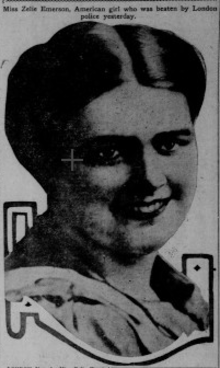Zelie Emerson
Zelie Passavant Emerson (1883 — March 1969) was an American suffragette in England. She suggested and then founded the Workers' Dreadnought newspaper with Sylvia Pankhurst, and she was injured by London police in a suffrage riot in 1913.
Zelie Emerson | |
|---|---|
.jpg) | |
| Born | 1883 Jackson, Michigan |
| Died | 1969 (aged 85–86) Lakeland, Florida |
| Nationality | American |
| Known for | founded the Workers' Dreadnought newspaper |
Early life
Zelie Passavant was born in Jackson, Michigan, the daughter of Hubbard Rufus Emerson and Zelie Passavant Emerson. Her grandfather was a Lutheran minister, William Passavant; her great-grandmother Fredericka "Zelie" Basse Passavant was the inspiration for the town name of Zelienople, Pennsylvania. Zelie's mother was linked romantically with Andrew Carnegie as a young woman, and remained a friend and correspondent of the industrialist into later life.[1]
Career

Emerson was active in the labor movement in Chicago for several years,[2] and worked at the Northwestern University Settlement house,[3] before she met Sylvia Pankhurst and moved to England. She was active in the Women's Social and Political Union in London, and in the breakaway group, the East London Federation of Suffragettes. In 1912, she joined Pankhurst in opening the organization's headquarters in Bow Road in East London.[4] Pankhurst wrote that Emerson recognised that the working class audience appreciated that winning the women's suffrage would benefit the men also.[5] Pankhurst and Emerson were arrested for violent demonstrating, including throwing stones at Bow police station[5] in February 1913, and sentenced to six weeks in Holloway Prison. Out on bail, they demonstrated again, and were sentenced to two months' hard labour.[6] On an occasion she was spared arrest, when Emerson with two others approached and whipped Dr Forward who had force-fed her for five weeks, declaring him unfit to practice and that he 'should be force-fed himself'. The doctor stated that he was unhurt in the incident.[5] Emerson was released after a hunger strike, forced feeding, solitary confinement, and a suicide attempt,[7] after seven weeks.[8][4] Her widowed mother was in London to advocate for her release.[9][10] American senator Charles E. Townsend also worked for Emerson's release.[11]
Emerson served on the Committee for the Repeal of the Prisoners' Act in 1913. In November 1913, Emerson was injured by London police in a suffrage riot.[12] She was found to have a concussion,[13][14] but within a month was arrested again for rioting.[15] Charges against her in this incident were dismissed.[16]
In 1914, at Emerson's suggestion,[17] Pankhurst and other members of the East London Federation of Suffragettes launched a newspaper, Workers' Dreadnought.[18] Emerson was arrested again in 1914, and there was talk of expelling her from the country, under the Aliens Act.[19] In poor health from her skull injury and the trauma of force-feeding[5], she was not to return to campaigning in the UK after "visiting" at her mother's house in Michigan by May 1914,[20] and she moved to Florida with her mother in 1916.[21]
In 1931, newspapers reported that she owned and operated a grapefruit orchard in Lakeland, Florida.[22] In 1958, Emerson and another woman citrus grower, Bessie Bruce, sued the county and the state over drainage plans that would negatively affect their crops.[23]
Personal life
Emerson died in 1969, aged 85 years, in Florida.[24]
References
- "The Munificent Gift" Jackson District Library.
- "Social Sets of Other Cities" Washington Post (May 4, 1912): 7. via ProQuest
- "Woman Santa for Strikers" Chicago Daily Tribune (December 22, 1910): 7. via ProQuest
- Rosemary Taylor and Sarah Jackson, East London Suffragettes (History Press 2014). ISBN 9780750960939
- Atkinson, Diane (2018). Rise up, women! : the remarkable lives of the suffragettes. London: Bloomsbury. pp. 363, 373, 441, 535. ISBN 9781408844045. OCLC 1016848621.
- "Two Months for Suffragists" New York Times (February 19, 1913): 5. via ProQuest
- "American Girl in Solitary Cell" Atlanta Constitution (April 1, 1913): 3. via ProQuest
- Elizabeth Crawford, The Women's Suffrage Movement: A Reference Guide, 1866-1928 (Psychology Press 2001): 522. ISBN 9780415239264
- "Miss Emerson Free Soon" New York Times (April 5, 1913): 1. via ProQuest
- "Seek Americans' Aid for Miss Emerson" New York Times (March 30, 1913): C4. via ProQuest
- "Senator Townsend to Aid Imprisoned Suffragette" Washington Post (April 2, 1913): 3. via ProQuest
- "Zelie Emerson is Seriously Injured by London Police" San Francisco Call (6 November 1913): 14. via California Digital Newspaper Collection

- "American Militant Injured in Riot" Sacramento Union (11 November 1913): 2. via California Digital Newspaper Collection

- "Zelie Emerson Hurt" New York Times (November 11, 1913): 4. via ProQuest
- "London Police Get Miss Emerson Again" New York Times (December 15, 1913): 4. via ProQuest
- "U. S. Suffragette Freed" Washington Post (December 24, 1913): 5. via ProQuest
- "Workers' Dreadnought". Spartacus Educational. Retrieved 2018-01-29.
- Elizabeth Crawford, The Women's Suffrage Movement: A Reference Guide, 1866-1928 (Psychology Press 2001): 184. ISBN 9780415239264
- "Emerson Arrested Again" New York Times (March 9, 1914): 5. via ProQuest
- "Zelie Emerson at Home" Boston Daily Globe (May 17, 1914): 8. via ProQuest
- "Noted Suffragist and Mother Will Make Home in Lakeland" Miami News (September 22, 1916): 5. via Newspapers.com

- "Pankhurst Crusader Now Grows Fruit in Florida" Hope Star (August 15, 1931): 2. via Newspapers.com

- "Suit Attacks Polk Road Drain Plan" Tampa Tribune (June 21, 1958): 4. via Newspapers.com

- "Obituaries" Tampa Tribune (April 1, 1969): 18. via Newspapers.com

External links

- Zelie Emerson at Find a Grave